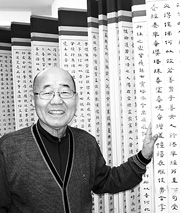Spiritual devotion sends man on artistic odyssey

Lee Seong-jo unveils his screen last Tuesday. By Song Yee-ho
Lee works under the pseudonym Namseok, which means “rock in the south.” High-status scholars often use pseudonyms.
“At the age of 60 I suddenly realized that I wanted to write down the words of Buddha,” Lee said. “This way, I thought the general public could understand the world of Buddhism and practice it during their everyday lives. I immediately started writing 33 characters on each of the 168 panels of the screen.”
He rarely left his workshop during the three years he spent writing in yeseochae, a calligraphy style invented by the Chinese king Qin Shi Huang around 200 B.C. To fill the gigantic canvas, he wrote out the sutra seven times. He had to use almost 50 brushes and spent 48 million won ($52,656) just to mount the paper. Lee claims he didn’t even catch a cold during the three-year project because of his belief in Buddha. He almost went blind, however. Despite eye surgeries, one of his eyes is now so damaged that it can only discern outlines.
After completing the screen, Lee lent the piece to a monk who said he needed it to attract worshippers to his shrine. Now that the shrine is flourishing, Lee once again has the screen in his possession, although he also wrote letters offering the screen to some 500 renowned monks and other acquaintances. One recipient was a leader among Cambodian monks, who visited Daegu to see the screen’s release to the public.
Lee entered the calligraphy world when he was 18 after graduating from Pusan National University with a degree in arts education. Soon after he became the youngest prize winner ever in the National Art Exhibition in 1959. He has won 13 prizes in the same exhibition in the past years. He has also brought different writing styles to the Daegu area, but never charges money for teaching calligraphy. Instead, Lee places emphasis on writing to expand the mind rather than simply practicing technique.
In large part, calligraphy brought Buddhism to Lee. His mentor in the art, Cheongnam Oh Je-bong, was a monk. One of Lee’s pieces found its way to Seongcheol, a widely known monk, who kept the work.
This encounter changed Lee’s perspective on spirituality. The secular world began to feel boring, and at age 28, he quit his career as an arts teacher at Andong Middle School in North Gyeongsang to devote himself to Buddhism. However, he couldn’t completely sever ties with the secular world and gave up monastic life after eight months.
To celebrate Lee’s 70th birthday, the Daegu Culture & Arts Center displayed the screen as well as 2,000 other pieces. The six-day exhibit of Buddhist art is among the largest ever to be hosted by an an individual. The works span Lee’s 12-year career of toiling in his workshop atop Palgong Mountain in Daegu.
By Song Yee-ho
JoongAng Ilbo
[yhwang@joongang.co.kr]










with the Korea JoongAng Daily
To write comments, please log in to one of the accounts.
Standards Board Policy (0/250자)